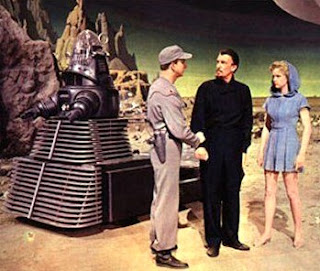Those audiences are greeted with Daniel C. Nyiri’s impressive set that nevertheless looks familiar. It’s a down-market, outer-borough New York apartment, reproduced with the detail we expect in a movie or TV show set. Some of those details—like the box of Ritz crackers, the Kix cereal on top of the fridge—suggest that despite the vaguely contemporary time in which the play takes place, this is really the sitcom 1950s, but with cell phones and collagen injections.
It’s the apartment of Maureen Mulligan (played by Christina Jioras), a plus-size and no longer young woman, who is getting ready for a blind and possibly last chance date with Joe Spinelli (Dmitry Tokarsky), perennially unattached and also middle aged. Maureen’s sister Sheila (Susan Abbey) is helping her prepare, with encouragement and makeup. Sheila was the pretty one, though lately obsessed with cosmetic surgery. She’s married to an upscale lawyer she’s worried is straying, the handsome Squire Whiting (Brad Curtis.)
While Brooklyn and Queens no doubt maintain some old ethnic enclaves (though I’d be surprised if there are many Irish parents who still expect one of their daughters to become a nun,) this has a very 50s sitcom feel: Irish and Italian Catholics, plus a token WASP, as seen through the comedic and highly verbal prism of predominantly Jewish writers.
All the characters in Jon Lonoff’s script for Skin Deep are witty, the story is sweet and slight, with a single psychological turn that Maureen eventually states directly, in case we missed it while laughing at the jokes. This play really is skin deep. But skin is important, too (it’s where we first feel the world, and where we get burned.) And there are worse ways to spend an evening than watching a live sitcom, especially with this ensemble of actors.
Not only are they individually talented, able to create convincing characters and relationships that have nuances that deepen the play, but they do so by working so well and so truthfully together. Credit for that must also extend to director Cassandra Hesseltine. Christina Jioras is winning, Brad Curtis brings out elements of his character that might otherwise remain latent in the script, Dmitry Tokarsky is solid and Susan Abbey is funny without losing her character’s dignity and humanity. The New York accents are pretty good, too.
There’s romance, misunderstanding and a touch of farce in the second act involving (as farce often does) closed doors hiding someone who shouldn’t be there, or open doors creating a wrong impression. It’s uncynical, moderately fast paced and not long.
There's some apparent playfulness with names. "Squire Whiting" comes close to being parody for the one WASP in the play. But I detect a pun in the heroine's name too--Maureen Mulligan--a mulligan basically being a do-over. A second chance for romance, get it?
There’s a lot about food, so expect to crave snacks afterwards. Food mentions could be another reason that this play is apparently done most often at dinner theatres. In fact, despite an Off-Off New York debut, this may be basically a direct-to-dinner theatre play, and I suspect that's an entire genre now. Still, the Redwood Curtain production is funny and enjoyable. Even without dinner.
Costumes are by Jenneveve Hood, sound by Jon Turney, props by Laura Rhinehart. Skin Deep continues weekends at Redwood Curtain through May 18.
Speaking of dinner theatre, Murder By Dessert presents Cinquo de Mayo mysteries at two local Mexican restaurants this weekend: at Capala Mexican Restaurant in Eureka on Friday and Luzmilla's in McKinleyville on Saturday, each starting at 9.
On Thursday and Friday (May 2, 3) at 8 p.m., the Arcata Playhouse hosts the physical theatre duo Wonderheads Mask Theater, performing an original piece, Loon. Co-artistic directors Kate Braidwood and Andrew Phoenix are graduates of the Dell’Arte International School, and their signature is larger-than-life masks and puppets, billed as “live-action Pixar.” Liz Nicholls in the Edmonton Journal described this show as “a simple, classic underdog story, the rediscovery of the sense of possibility. And it’s told with beautiful physicality.” Arcata Playhouse.org.
Also this weekend, Proof ends its run at HSU. It's the Pulitzer Prize winning drama by David Auburn. Produced by HSU Theatre and directed by Michael Thomas, it features Dakota Dieter, James Read, Kyle Handziak and Queena DeLany. Lynnie Horrigan designed the set, Glen Nagy the sound, James McHugh the lighting, Marissa Menezes the costumes and makeup. More information: http://HSUStage.blogspot.com. Thursday-Saturday at 7:30 p.m., with the last show on Sunday at 2, in Gist Hall Theatre. HSU Stage.
The 1960s musical Hello, Dolly! is performed at Ferndale Repertory Theatre at 8 p.m. Fridays and Saturdays, 2 p.m. Sundays. Directed by Justin Takata, with musical direction by Tina Toomata (you say Takata, I say Toomata), choreography by Linda Maxwell and scenic design by Liz Uhazy, it features Rae Robison, Dave Fuller, Erik Standifird, Molly Severdia, Dante Gelormino, Sasha Shay, Lizzie Chapman and Brodie Storey heading a large cast. It closes May 12.
Antigone continues at Eureka High, Thursday through Saturday at 7:30.

























